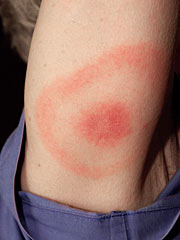AARP Eye Center
Tick Attack: How To Avoid Lyme Disease This Summer
By Candy Sagon, May 25, 2011 08:00 AM

It can start with a bull's eye rash and that achy feeling you get when you have the flu. Except that it's not the flu, it's probably Lyme disease, a bacterial illness carried by a tick that's no bigger than the head of a pin.
The culprit is the deer tick, which carries bacteria it picks up from biting deer or mice. The disease is named after Old Lyme, Conn., the city where it was first reported in the U.S. in 1975, and May through July is prime Lyme season.
The tick is so tiny and its bite painless that most people don't even realize they've been bitten.
That's what happened to my daughter, who recently went hiking in the Virginia countryside with her boyfriend. Because it was warm, she wore shorts instead of long pants. Neither one of them thought about using an insect repellant.
A few days later, her joints hurt like crazy and she found that bright red bull's eye on her leg. The nurse at the local clinic took one look at that rash and prescribed a course of antibiotics.
Not that it's any consolation, but my daughter is part of a growing trend. The number of cases of Lyme disease is on the rise, according to the Centers for Disease Control and Prevention. Most of the cases are concentrated in the mid-Atlantic and Northeast portions of the country and the North Central states around the Great Lakes.
Your risk of getting Lyme disease is highest now, when the weather is warm and you're more likely to be outside in wooded areas, hiking, camping, gardening or walking the dog.
Not everyone who's bitten by a tick gets ill, but those who do, the first symptoms are often flu-like - muscle and joint pain, headache, fatigue, chills - along with that telltale rash that many people (but not everyone) get.
If you're treated with antibiotics in the first stage of the disease, you're likely to recover completely. More serious problems occur if the disease is left untreated.
There is a blood test that can confirm a diagnosis of Lyme disease, but it's most accurate a few weeks after the infection sets in, past the most effective time to start antibiotics. For this reason, doctors often prescribe antibiotics just to be on the safe side.
Here are some tips to prevent tick bites this summer:
* Keep your dog on a leash when walking near wooded areas; try to stick to trails and avoid walking through low bushes and tall grass. Check your pet for ticks after spending time outdoors.
*Wear shoes and long pants tucked into socks when walking in wooded places. Use insect repellant with DEET (follow instructions carefully and don't use it on young children).
*Shower when you come back indoors after walking in wooded places; using a washcloth may help remove any unattached ticks.
*Use tweezers to carefully remove a tick on your skin, grasping it near the head and pulling it carefully and steadily so you don't break the body off, leaving the head still attached.
Photo credit: James Gathany/Centers for Disease Control and Prevention, Public Health Image Library























































